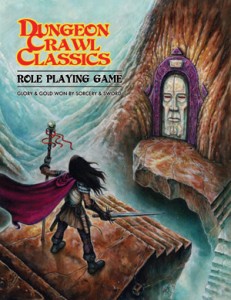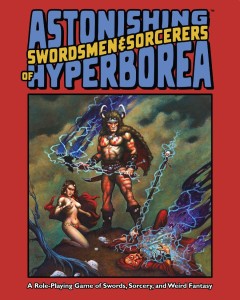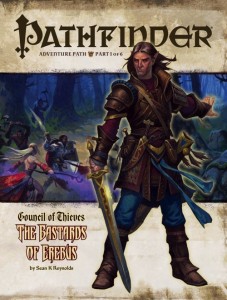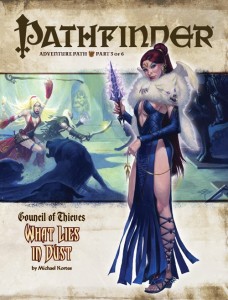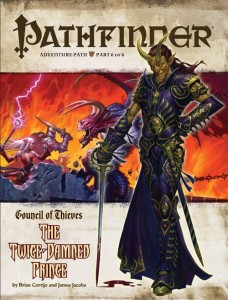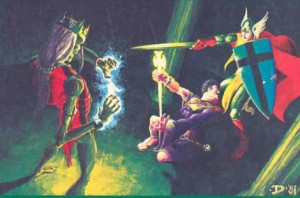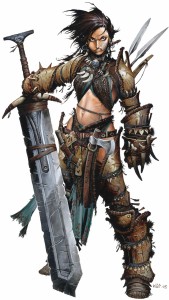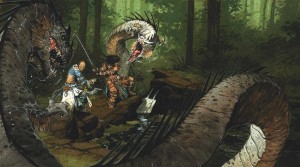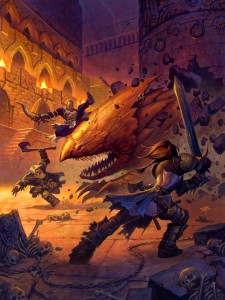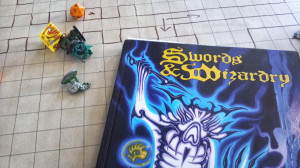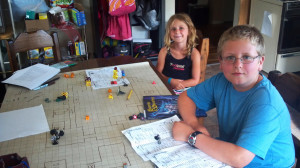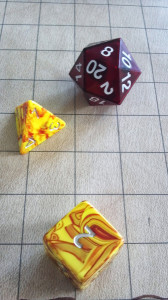 The ENnies are an RPG awards that have become the Official Gen Con Awards. It started out as something small on EN World message boards. It has grown tremendously and become in my opinion the most important RPG awards there are. I do admit to being biased as I was a Judge for the ENnies for six years. What follows are some stories and gossip on what has happened with the ENnies behind the scenes. Some of it is good and some of it is bad. No names are going to be mentioned because while I am writing this to inform people it is not my intention to embarrass or call out any persons. All opinions right and wrong are mine and mine alone.
The ENnies are an RPG awards that have become the Official Gen Con Awards. It started out as something small on EN World message boards. It has grown tremendously and become in my opinion the most important RPG awards there are. I do admit to being biased as I was a Judge for the ENnies for six years. What follows are some stories and gossip on what has happened with the ENnies behind the scenes. Some of it is good and some of it is bad. No names are going to be mentioned because while I am writing this to inform people it is not my intention to embarrass or call out any persons. All opinions right and wrong are mine and mine alone.
I’m really not sure why I ran for ENnies judge. The first year I did it I did not get voted in, but I did the second year I tried. I had no idea what kind of hell I was getting myself into. It was fun and I’m very happy I did, but that first year was difficult because of the circumstances. The other judges that year were great. It was a collection of some very intelligent and experienced gamers. We had some great conversations about what should and should not get nominated. The purpose of the judges is to read all the books that publishers submit and come to a consensus list of five books for each of the categories. Once the judges pick the nominations it is put up to a fan vote. In those days it was also the Judges responsibility to create categories that fit the products submitted. For instance we had the best Monster Supplement that year because we saw many monster books submitted. The reason it was hell was almost everything came at the last minute. The last week of May and all of June I had about one hundred and fifty RPGs to read and it is a lot more work than it sounds.
Everything that was submitted was read cover to cover at least once. I had a notebook I would take notes in about each book. It wasn’t just the content we were judging but the production values, interior art, cover art, rules, cartography, and everything about a book. I learned a lot about layout that year. The concept of excessive white space for instance was not something I ever noticed before. I was paying attention to fonts, font size, how pictures were used to help the text flow, or in the case of bad lay out, just interrupted the text. After reading through everything I had a pile of books that I felt were not good enough for any category so I put those to the side. All the others got read for a second and sometimes third time as I reduced my lists of what was best. During this time the judges are communicating online with what they liked and did not like. There were more than a few times that I had to go get a book out of my “no like” pile and reread it because another judge or two sang its praises. Doing this was in addition to everything else one normal does, like go to work. I had a weekly game and I usually was social with friends during the week. To get it all read and to do my job properly I canceled gaming for June. I didn’t see anyone socially and even took vacation time to get everything finished that I had to finish. My girlfriend at the time broke up with me as for that month reading gaming books became her adversary.
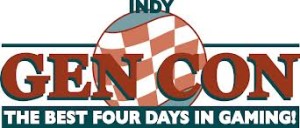 Later years became better as companies would not all wait to the last minute to submit books to us. We still felt that too many of them did but that was really to their disadvantage. The books we got after Gen Con and early in the year we had months of discussion on them and more time to read and reread. Books that came in at the very end of the submission period could not get that kind of scrutiny because of the time crunch.
Later years became better as companies would not all wait to the last minute to submit books to us. We still felt that too many of them did but that was really to their disadvantage. The books we got after Gen Con and early in the year we had months of discussion on them and more time to read and reread. Books that came in at the very end of the submission period could not get that kind of scrutiny because of the time crunch.
I bring up all the time devoted to reading because we were occasionally accused of not reading everything. One year we were even called out by at the time possibly the biggest name in gaming. Those years I really feel we did read it all. I wasn’t the only one that took vacation time and missed social and family events to get the job done. After we put in all that hard work and had people claim otherwise, that upset us. Some of us blew our tops and angrily replied. I had friends that asked me in private if I really did read everything or if I faked it. I would tell them the truth that I read everything and was insulted that they would imply otherwise. When I signed up to be judge it was a commitment and a responsibility that I had to follow through to the best of my ability. I took it very seriously even though awards are not always that well respected by the fans and by publishers.
In later years when I was and was not a judge I got the feeling that some judges were not reading everything. I’d talk about specific books with them and they were not able to have a discussion about it. Some of the most difficult books to judge are supplements submitted to games the judges don’t own and don’t play. I talked to judges that would read the supplement but not the game it was based on. It’s impossible to judge a supplement if you don’t know the rules and what the supplement is building off of. There is no oversight for the judges. Each judge does their reading in their own place in different part of the US and even the world. They really need to require more transparency for the judges. They should be required to go to Gen Con. At the very least the people running the ENnies should meet with the Judges. Otherwise it is too easy to lie and cheat one’s way into being a judge.
As RPGs grew on the net, other sites devoted to gaming emerged. People had blogs and then podcasts about gaming. I don’t know whose ideas it was to include them in the ENnies as categories but I thought it was a mistake then and still do. As judges we were told we had control of the categories but when some of us talked about not including Best Blog and Best Podcast the Powers that Be told us that was not a possibility. We had freedom when I was first a judge and it worked. When I stopped being a judge much of that freedom had been taken away. My guess it was done so to appease people who disliked the ENnies. We had some publishers that would never enter and then there were game sites that would just talk bad about the ENnies because it is the internet and that’s what people do on the internet.
Podcasts were the worst. It was amateur radio about gaming done in a way that made me want to quit gaming. We had some that were in excess of three hours. People were coughing into microphones. There was dead air. None of the ones I listened to sounded like they were edited or that there was much of a plan going into them. Some were of people actually playing the games. They gave no lead in like what had happened before, what the plot was, and in many cases what the game was. It would literally be thirty minutes before I could figure out what they were playing. I nominated many podcasts based on length of episodes, the shorter the better. Some podcasts tried to be news shows. I would be listening to a podcast in May that were recorded and aired in November. The breaking news was mostly unimportant by then and the guesswork they did on what companies would be doing would be proved wrong. Having to include and listen to podcasts was one of the main reasons I stopped running for ENnies Judge.
Some publishers would enter others would not. Steve Jackson Games I think entered once or twice by accident. At one time I had a contact within the company who I talked with about the awards. He loved the idea and he was ready to submit stuff. Then one day I just stopped hearing from him. When I finally did hear back it was short message that basically said someone higher in the company had told him SJGs would never submit anything to the ENnies and he was told to cease all communication with me. Goodman Games is another odd one. They used to submit modules and some sourcebooks and we would nominate them because they were good books. I heard Goodman Games stopped submitting product because they would rarely win the awards. It’s a fan vote so we have no control over that and we know it is hard to win going up against companies like Wizards of the Coast, Paizo, White Wolf, Green Ronin, and other companies that were just hugely popular. Upsets did happen from time to time. The way the awards are structured being nominated is an award in itself. That is being picked by the experts, the judges that have read everything. If we see seventy adventures in a year and pick one of yours to be top five that’s pretty impressive. Some companies just did not believe it or did not want to see it. Others usually small companies would thank us profusely. They would see a sales bump the week after we made our nominations.
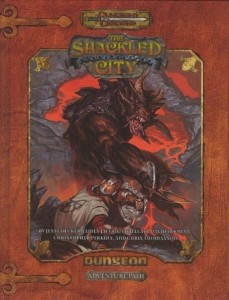 In 2006 we were blindsided by a controversy I was not expecting. I’m still not sure if it was a legitimate complaint or just people airing sour grapes because they lost. Shackled City hardcover was entered by Paizo Publishing. It is a great product that reprints the adventures of the Shackled City AP that appeared in Dungeon Magazine. They expanded on those adventures to include more information especially about the city of Cauldron the setting for most of the Adventure Path. We, the judges, nominated for Best Adventure and for Best Campaign Setting/ Setting Supplement. It won gold for both categories and then some people complained that the book cannot be both an adventure and a setting book. I disagree as there have been books that are both setting and adventures. RPG books can’t always be so easily classified as just one thing.
In 2006 we were blindsided by a controversy I was not expecting. I’m still not sure if it was a legitimate complaint or just people airing sour grapes because they lost. Shackled City hardcover was entered by Paizo Publishing. It is a great product that reprints the adventures of the Shackled City AP that appeared in Dungeon Magazine. They expanded on those adventures to include more information especially about the city of Cauldron the setting for most of the Adventure Path. We, the judges, nominated for Best Adventure and for Best Campaign Setting/ Setting Supplement. It won gold for both categories and then some people complained that the book cannot be both an adventure and a setting book. I disagree as there have been books that are both setting and adventures. RPG books can’t always be so easily classified as just one thing.
This past year has also not been without possible problems. When the judges wanted to discuss what should be nominated they wanted to use Skype. It would have been a great way to communicate and I wish we had that ability when I was a judge. But one of the judges refused, and for some reason, instead of majority rules, which is the way it is set up, Skype was not used. Instead the judges had to have the discussions in a less efficient and much slower method of e-mail. That’s a situation that management should be watching over and step in.
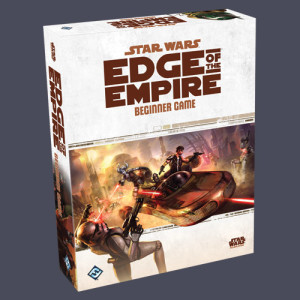 Another more alarming example from this year is the exclusion of Star Wars Edge of the Empire Beginner Box. It was submitted but left off all the nominations. It was not left off because most of the judges don’t like Star Wars or felt that other products were just better. It was left off because one judge didn’t like the special dice the game uses and refused to let it get nominated for anything. It is fine that a judge didn’t like the product but no one judge should be able to influence the nominations and have their opinion override the others.
Another more alarming example from this year is the exclusion of Star Wars Edge of the Empire Beginner Box. It was submitted but left off all the nominations. It was not left off because most of the judges don’t like Star Wars or felt that other products were just better. It was left off because one judge didn’t like the special dice the game uses and refused to let it get nominated for anything. It is fine that a judge didn’t like the product but no one judge should be able to influence the nominations and have their opinion override the others.
Being a judge for the ENnies was great. I came across a lot of products that I never would have otherwise. I loved that I was there to help open up the awards from just d20 to all RPGs. I think the awards have lost focus on that as we see more items that are not RPGs in them. Voting for the awards is taking place now and is going to be open till July 31st. I encourage all gamers to go and vote. It doesn’t matter if you’ve only read or played a few of the items on there. The more votes that the awards get and the more feedback they get from fans can only improve the awards.
Chris Gath. I’ve been gaming since 1980 playing all kinds of games since then. In the past year I’ve run Pathfinder, Dungeon Crawl Classic, Paranoia, and Mini d6. My current campaign is mini d6 and we are using that for a modern supernatural conspiracy investigative game. On some forums I’m known as Crothian and I’ve written a few hundred reviews though I took a sabbatical from reviewing for a few years as it burnt me out. I was also an judge for the Gen Con awards (ENnies) six times. Jeff, the owner of this blog, is one of my players and a good friend.

